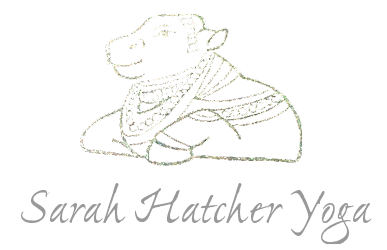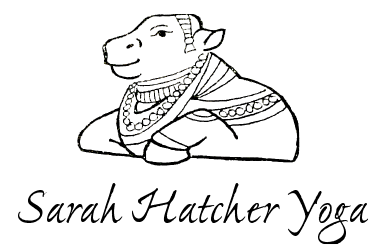Marichyasana C - "Do your practice (research!) and all is coming!"
This blog post comes from the weekend workshop held last weekend in Boise, Idaho at Sage Yoga Boise. During Mysore, there were a few individual questions about Marichyasana C, and this posture has been on my mind for a while now. This asana-related blog post is for those out there who are just learning Marichyasana C, and who are doing their research. Hopefully the seasonal practitioner will get something from this as well.

Didn't take any pictures from the workshop in Boise, but here is one worth admiring. Sawtooth Botanical Garden's treasure: the Tibetal Prayer wheel - one of two in North America; blessed by His Holiness the Dalai Lama. Ketchum, Idaho.
The first few times that I tried to do Marichyasana C, I remember being quite stumped at how to twist around the obstacle of my own outer leg to successfully bind my hands. Practicing Marichy C and teaching Marichy C have offered some insights into the asana that I would love to share with you all. Practicing this posture is always interesting, the posture itself is always morphing. Spending time here strengthens the abdominals, opens the hip flexors, and once happily bound, the asana also brings insight into shushumna nadi - the greatest channel that rises from the pelvis to the top of the head!
Pattabhi Jois in "The Yoga Mala" writes:
"flatulence, indigestion, and constipation are eliminated. Some women suffer from abdominal pain during menstruation. This is removed by the practice of the Marichys. The womb becomes powerful and enables a woman to carry a child strongly, and miscarriage due to weakness is cured. The vata pitta kosha (large intestine and gall bladder) are purified, as is the manipura chakra (third chakra at navel center), and the body gains strength and power."
Kino McGregor recently wrote an article about Marichyasana C (you can read it here: http://www.miamilifecenter.com/index.php?page=articles) where she calls this posture a way to “help build a deeper awareness of the essential breath-bandha connection and encourages the life energy rise along the central column of the subtle body.”
This posture is to some people, a deal breaker. Binding is difficult, easy breathing is difficult, and to get a long spine once you have bound your hands to extend upward and away from the earth is also a challenge. Here are just a few of your obstacles:
-It is the first deeply rooted seated twist in the primary series: in the previous seated postures before this one, there is a slight twisting of the body to forward fold over the extended leg(s) and the bent leg (Paschimottonasana, Tirianga Mukha, Janu Sirsasana), but these twists are small in comparison.
-Marichyasana C is your first asana (besides Purvottonasana) in the primary series, where we are not folding forward, we are lengthening away from the earth upward.
With these challenges facing you, you are in for deep study to understand this posture. There are tools to obtaining peace here! One tool in your arsenal is the sensation and memory of two foundational twists you experience earlier in the standing series - Parvritta Trikonasana, and Parvritta Parschvokonasana. These sergeants of wisdom are your guides to learning more and more about Marichyasana C. If revolved triangle or revolved side angle are difficult for you - try researching these two postures, and working on the foundations of these: spend fifteen to twenty-five breaths here instead of five.
The How-To:
Marichyasana C - from Dandasana (sit with your legs straight out in front of you), begin by bending your right leg and planting your foot so that your outer foot is in line with your outer hip. Both hips are on the ground - if you have a backward tilted pelvis when you sit in Dandasana or when you do this action, sit on top of a blanket or a wedge to tilt your pelvis forward - get both hips firmly planted on your mat.
On an exhale, move the belly area completely away from your center while maintaining a connection to your lower belly and mula banda or what Kino calls, "your breath bandha connection". Then begin to twist around this hollow space of the navel while it is empty of breath (uddiyana bandha). Continue to breathe into this space of complexity (it will never get old researching this). Use your out-breath to keep moving your lower abdomen around the outer leg as you twist, still drawing inward to keep a support system viable! Without the exhaled breath and the awareness of the body feeling empty - this posture will continue to be challenging.
Then, move the right knee towards the left shoulder and hollow your chest and your entire belly and abdomen, slightly leaning back away from the bent right thigh bone, keeping your left hip from moving backwards (try to keep your hips square here). And using your breath, wrap your left arm downwards and close to the outer right knee as possible. Keep your left shoulder strapped tight to the right knee and spin the arm in an internal rotation ontop of the left thigh bone - seeking to grab the right hand behind the back.
Tim Miller would say with the Marichy's..."Bind low and wrap high". It is difficult to bind "low" if the shoulder is not even touching the knee or the leg to begin with. So, to mend this task - try hugging your leg and bringing your opposite shoulder to the opposite knee while you hollow your insides - simply put, get a connection with the bandhas here. If you can get your shoulder to touch, you may be able to bind. If there is a huge gap between shoulder and knee - watch out, this may be a sign that you may not be ready to bind. If this is the case, stay here twisting your thoracic spine from your chest area instead of twarting your arm around your leg when the foundations may not be ready.
Female students, I tell them to "move your female business out of the way" in humor and in light. (On a side note, if you are pregnant, lay off this asana until you are done carrying - the Yoga Mala says, "pregnant women should not practice this asana after the second month"). Yes, you have got to move your dinner, move your what-ever-you-ate-recently out of the way, and your bust line out of the way to get around your leg! Keeping a very straight spine is the goal once you are in the asana - but to get into it, draw the navel back into the spine and at the same time, keep the spine way back away from the leg as your move your upper torso (your female business) around.
Ah, you bound! Then, extend magically away from the earth - grounding BOTH hips - which is different than Marichyasana A. Here you are really finding that root lock connection - seek to bring both hips towards each other and in line; try not to let one be behind the other - squeeze those legs towards each other and draw down through the dynamicism of the extended flexed foot leg. Root that bind you have with your hands and work that wrapped arm behind you: the wrapper is the grabber - so if you are wrapping your right leg - the left arm grabs the right wrist and then you can work your right hand to the top of the left thigh.
Stamp that right leg (the bent legged foot into the earth) then go upwards and twist - seek a spot behind you for guidance and find that drishti you can lock your focus on. Breathe here - if you are new to binding, once you are bound, stay for 25 breaths! With time, you will only need to stay for 5 breaths. And later, much later, you will enter the asana in the inhalation - just as the masterful count asks you to, "Marichyasana C - Supta Jump : Inhale!" Only do this when you are comfortably able to bind.
Eventually, this posture is a joyful deep twist, where you link the elements of alignment and bandha together to make this postures successful. The subtle body has got to get on board: uddiyana and mula bandha, the breath must be free and without straining as you begin to twist, and you must be informed of how the lower body does not want to twist. Be a scientist - take your time informing yourself of what needs to happen, dissect this delicious asana - and all other twists later will be much, much easier.
As Guruji is quoted as saying, "Do your practice and all is coming"...I want to add to this - "Do your research in your practice...and all is coming!"
Happy twisting!

Here I am at the Sawtooth Botanical garden. Thinking of Marichyasana C...and smiling!

